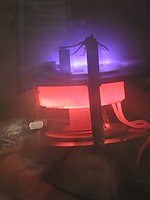
Photo from wikipedia
The Si particle waste cut from diamond wire in photovoltaic industry is chose as an environmental friendly and low-cost resource for Li-ion battery. In this study, the pollutions of SiO2… Click to show full abstract
The Si particle waste cut from diamond wire in photovoltaic industry is chose as an environmental friendly and low-cost resource for Li-ion battery. In this study, the pollutions of SiO2 layer, adhered trace metal and organic impurities on the Si particle waste can be removed by the facile processes of corrosion and pyrolysis. The removal ratios of organic and metal impurities were 70.42% and 66.76%, respectively. The different kinetic models for the removal of metal impurities demonstrate that the leaching is more suitable for controlling by second-order reaction of homogeneous models (R2 =0.992, m=2). The preparation analysis of porous Si@SiO2 with a 3D cluster nanoporous structure using a special bubble corrosion method was firstly proposed and discussed intensively. The first discharge and charge capacities of porous Si@SiO2 @C composites reached 2579.8 and 2184.1 mAh/g, the initial CE reached 84.66%, and the corresponding capacities after 100 cycles reached 1051.4 and 1038.2 mAh/g, which showed the better electrical performance. This study establishes a theoretical basis for recycling Si particle waste cut from diamond wire, and provides technical support for the energy sustainable development.
Journal Title: Journal of hazardous materials
Year Published: 2020
Link to full text (if available)
Share on Social Media: Sign Up to like & get
recommendations!